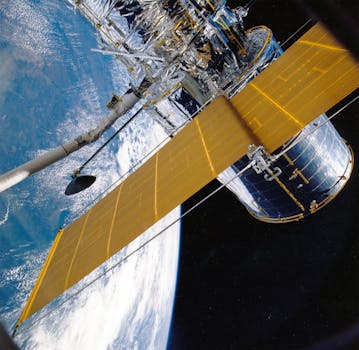From Geostationary to Low Earth Orbit: The Evolution of Satellite Telecommunications in 2023
The satellite telecommunications industry has undergone significant transformations in recent years, with a shift from geostationary to low earth orbit satellites. This evolution has enabled faster, more reliable, and widespread internet connectivity, revolutionizing the way we communicate and access information.

From Geostationary to Low Earth Orbit: The Evolution of Satellite Telecommunications in 2023
Focus Keyword: Satellite Telecommunications
Satellite telecommunications has come a long way since its inception, with significant advancements in technology and infrastructure. The shift from geostationary to low earth orbit satellites has been a major milestone in this evolution, enabling faster, more reliable, and widespread internet connectivity. In this article, we will explore the history of satellite telecommunications, the benefits of low earth orbit satellites, and the current state of the industry.
The first geostationary satellite was launched in 1963, and since then, geostationary satellites have been the backbone of the satellite telecommunications industry. Geostationary satellites orbit the earth at an altitude of approximately 36,000 kilometers, allowing them to remain stationary relative to a fixed point on the earth’s surface. This made them ideal for providing television broadcasting, telecommunications, and weather forecasting services. However, geostationary satellites have some limitations, including high latency, limited bandwidth, and high operating costs.
The advent of low earth orbit satellites has addressed many of these limitations. Low earth orbit satellites orbit the earth at an altitude of approximately 160-2,000 kilometers, which reduces latency and increases bandwidth. Low earth orbit satellites are also less expensive to launch and operate, making them a more viable option for many applications. One of the most significant benefits of low earth orbit satellites is their ability to provide global internet coverage, including in remote and underserved areas.
The Benefits of Low Earth Orbit Satellites
Low earth orbit satellites have several benefits that make them an attractive option for satellite telecommunications. Some of the key benefits include:
Lower latency: Low earth orbit satellites have significantly lower latency than geostationary satellites, making them ideal for real-time applications such as video conferencing and online gaming.
Higher bandwidth: Low earth orbit satellites have higher bandwidth than geostationary satellites, making them suitable for applications that require high-speed data transfer.
Global coverage: Low earth orbit satellites can provide global internet coverage, including in remote and underserved areas, making them an ideal solution for providing internet access to underserved communities.
Cost-effectiveness: Low earth orbit satellites are less expensive to launch and operate than geostationary satellites, making them a more viable option for many applications.
Current State of the Industry
The satellite telecommunications industry is rapidly evolving, with many companies investing in low earth orbit satellite constellations. Some of the key players in the industry include SpaceX, Amazon, and OneWeb. These companies are launching thousands of low earth orbit satellites to provide global internet coverage and other services.
The shift to low earth orbit satellites has also led to the development of new technologies and innovations. For example, the use of phased arrays and other advanced antenna technologies has enabled the creation of smaller, more efficient satellites. The development of new propulsion systems has also enabled satellites to maneuver and change orbit more efficiently.
Conclusion
In conclusion, the evolution of satellite telecommunications from geostationary to low earth orbit satellites has been a significant milestone in the history of the industry. Low earth orbit satellites have enabled faster, more reliable, and widespread internet connectivity, revolutionizing the way we communicate and access information. As the industry continues to evolve, we can expect to see even more innovative technologies and applications emerge, further transforming the satellite telecommunications landscape.





